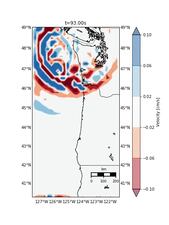Fifty new simulations of "the big one” show how a magnitude 9.0 earthquake from the Cascadia Subduction Zone could play out.
The Cascadia Subduction Zone is a fault that sits along the bottom of the Pacific Ocean, and two plates colliding could eventually slip, triggering a massive earthquake that could shake the northwest.
>> 5 things to help you easily understand 'the 'ig one'
A University of Washington research project ran simulations using different combinations for three key factors: the epicenter of the earthquake, how far inland the earthquake will rupture and which sections of the fault will generate the strongest shaking.
The results show that the location at which the earthquake starts matters most, and the scenarios can drastically change depending on where the earthquake hits.
Scroll down to keep reading.
Related headlines to 'the big one'
- SLIDESHOW: Geologic illustrations explain the Cascadia subduction
- How to build a 7-day disaster emergency survival kit on a budget
- State's largest quake drill ever to test readiness for 'The Big One'
- Mexico's strongest earthquake in a century recorded at Mt. Rainier
- 5 things to help you easily understand 'the big one'
DOWNLOAD THE KIRO 7 NEWS APP HERE
One animation shows a scenario that’s bad for Seattle, in which an earthquake begins off the southern Oregon coast and the fault line breaks north, with seismic waves building up along the way. By contrast, a better scenario for Seattle would actually be an earthquake that begins closer – off the Olympic Peninsula – where the fault line breaks away from the city.
But make no mistake, the magnitue 9.0 scenarios are bad, and models show the ground shaking for 100 seconds. That’s four times longer than it shook during the 2001 Nisqually quake, which, at magnitude 6.8, did plenty of damage and rattled many nerves.
"We know a magnitude 9.0 earthquake occurred in Cascadia in the year 1700 but we didn't have any seismometers or recording instruments at the time," said Erin Wirth, a postdoctoral researcher at the University of Washington.
Wirth said scenarios show the level of shaking could be 10 times different depending on where the earthquake begins and the direction in which the fault line ruptures.
Past models have looked at one or two scenarios, but this is the first study with 50 scenarios. The point is to show the wide range of possibilities of a magnitude 9.0 earthquake. The next steps for researchers is to take this information and model the impacts on tsumamis, landslides and tall buildings in Seattle.
They hope that information will help planners and emergency managers prepare for "the big one."



